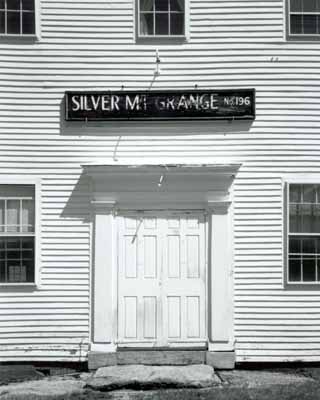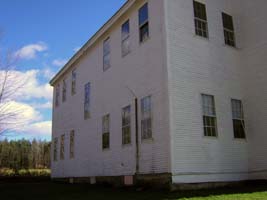| ← back |
Colonial Meetinghouses Featured in this Project |
next → |
 Name of Meetinghouse: The Lempster Meetinghouse
Name of Meetinghouse: The Lempster Meetinghouse
View on a mapStreet Address of Meetinghouse: 112 Lempster St., Lempster, NHYear(s) Built: 1794 National Register of Historic Places Designation: Yes - 1980 New Hampshire State Register of Historic Places: ? Organization responsible: The Friends of the Lempster Meetinghouse (Town of Lempster) Organization's address: 5 Wheeler Lane, Lempster, NH 03605 Organization's web site: Friends of the Lempster Meetinghouse Town Information: Town of Lempster, NH Tax status: Tax Exempt 501(c)(3) Contact: Laura Pinkney, PO Box 213, Lempster, NH 03605 Telephone: (603) 863-8180 E-mail: none This page was last updated on: March 26, 2009 Acknowledgements: The following text has been taken from Sacred and Secular: Historic Meetinghouses and Churches of the Monadnock Region, 1750-1850, published in 2006 by the Historical Society of Cheshire County, and has been used by permission.The Lempster meetinghouse was built in 1794 as a Congregational Church and for civic affairs. When it was first constructed it was a large, tall, and rectangular building with double side entries with double holy doors. Opposite the main entry was a raised pulpit with a window behind the pulpit. The exact location of the first meetinghouse is not clearly known, only the general vicinity of the building.
With the meetinghouse in town hands, the galleries were remodeled into a full second floor, with a four foot attic space between the first and second floor and a true attic above the second floor. A large stage was constructed in the downstairs hall. The building was used as a town hall and meeting place until 1858. From 1858 until the 1870s the meetinghouse was known as Union Hall. During this time the meetinghouse was used very little and there was discussion of razing the structure or moving it. Yet for unknown reasons neither was accomplished. Around 1872 the Lempster High School was housed in the largest upstairs room and the public library occupied the smaller adjacent room. The high school operated in the meetinghouse for less than 20 years, but the library remained in the building until 1966.
With the maintenance and repairs being well tended too, the meetinghouse became an attractive building, becoming the governmental and social center of Lempster once again. In 1976 the Lempster Bicentennial Committee began an effort to have the building listed on the National Historic Register. These efforts were finally rewarded in 1980. From this point on Grange membership and maintenance on the building began a slow decline. The town, accustomed to leaving the maintenance to others, seemed to forget that an old building needed constant care.
The Lempster Meetinghouse is one of only thirteen surviving two-story meetinghouses in New Hampshire that have retained much of their original appearance. |

|

|
 In 1822 Deacon John Taylor was given the contract to move the building approximately 2.5 miles
to its current location at the head of Lempster Street.
The bell tower was added at this time.
The meetinghouse continued to be used as a church and for town meetings until 1835,
when the Congregational Society constructed a new church in the village and abandoned their use of the meetinghouse.
In 1822 Deacon John Taylor was given the contract to move the building approximately 2.5 miles
to its current location at the head of Lempster Street.
The bell tower was added at this time.
The meetinghouse continued to be used as a church and for town meetings until 1835,
when the Congregational Society constructed a new church in the village and abandoned their use of the meetinghouse.
 Silver Mountain Grange, Number 196, is credited with saving the meetinghouse.
In 1897 they leased the entire upstairs for 99 years and shared maintenance duties with the town.
The Grange members were diligent stewards.
They installed electric lights in 1938 when the first Rural Electric Association
light pole was placed across the street.
(The pole still stands today as the first pole installed by the association).
Central oil heating was added in the 1950s.
Silver Mountain Grange, Number 196, is credited with saving the meetinghouse.
In 1897 they leased the entire upstairs for 99 years and shared maintenance duties with the town.
The Grange members were diligent stewards.
They installed electric lights in 1938 when the first Rural Electric Association
light pole was placed across the street.
(The pole still stands today as the first pole installed by the association).
Central oil heating was added in the 1950s.
 Town meetings continued in the large downstairs hall until the building was deemed
unsafe for large gatherings in 1994.
At this time there was an active movement to dispose of the building.
A few conscientious citizens and the Lempster Historical Society
were able to sway voters to preserve the building.
The town voted to appropriate money and to form a committee to begin much needed repairs.
Utilizing the help of volunteer labor the committee accomplished a great deal with a small budget.
In 2002 the town organized a building needs group to assess the condition
and viability of all of Lempster's buildings.
In 2006, when the work of this committee was completed,
the condition of the meetinghouse caused great concern.
Because of this concern, The Friends of the Lempster Meeting House was formed,
a community group whose mission is to save and oversee the conservation
and perpetual care of their town treasure.
Town meetings continued in the large downstairs hall until the building was deemed
unsafe for large gatherings in 1994.
At this time there was an active movement to dispose of the building.
A few conscientious citizens and the Lempster Historical Society
were able to sway voters to preserve the building.
The town voted to appropriate money and to form a committee to begin much needed repairs.
Utilizing the help of volunteer labor the committee accomplished a great deal with a small budget.
In 2002 the town organized a building needs group to assess the condition
and viability of all of Lempster's buildings.
In 2006, when the work of this committee was completed,
the condition of the meetinghouse caused great concern.
Because of this concern, The Friends of the Lempster Meeting House was formed,
a community group whose mission is to save and oversee the conservation
and perpetual care of their town treasure.